Black-crowned Night Herons are the most widespread heron in the world, breeding on all continents except Antarctica and Australia. They’re relatively common in northern Utah, although it’s somewhat unusual for me to see them around here during winter.

1/1600, f/8, ISO 500, 500 f/4, 1.4 tc, natural light
So two days ago I was surprised to find this juvenile still lurking around the wetlands of the Great Salt Lake. We’re in the middle of an inversion which means it’s very cold (I was shooting in temps of -10 degrees F yesterday morning) so most still water is frozen solid. This bird was standing on ice with a thin layer of snow on top.
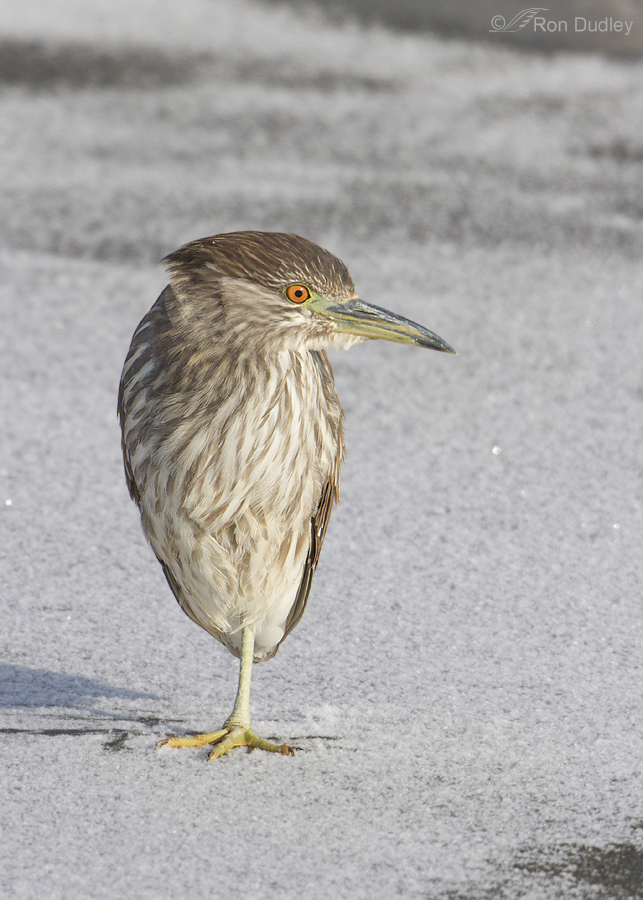
1/1600, f/8, ISO 500, 500 f/4, 1.4 tc, natural light
Juveniles look very different from adults. Instead of the basic black, white and gray colors of the adults these young birds are brown-streaked ventrally…

1/1250, f/8, ISO 500, 500 f/4, 1.4 tc, natural light
and mostly solid brown dorsally. This orange-chrome eye color will turn bright red in the adult.
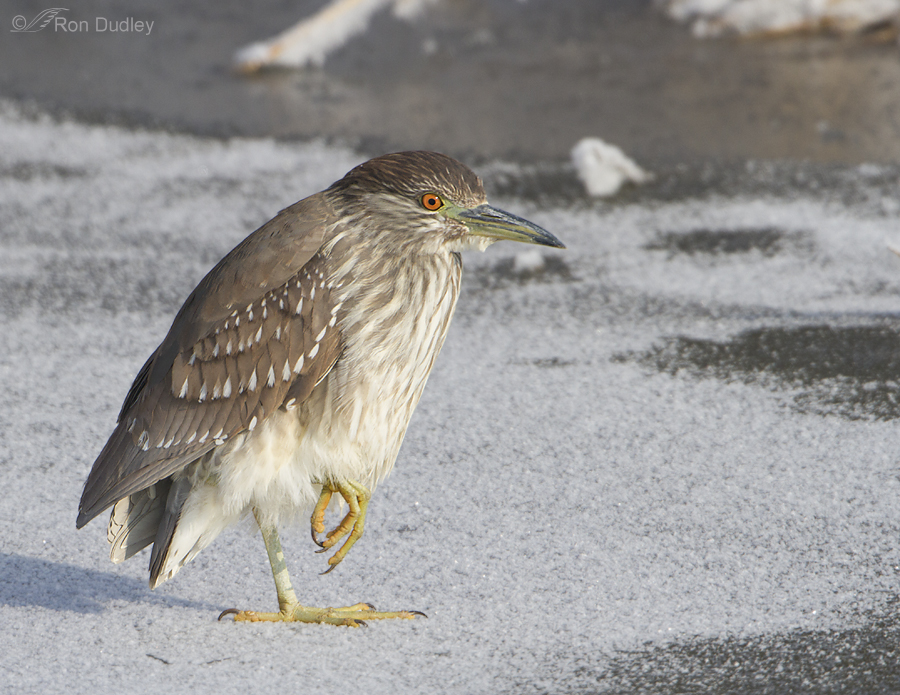
1/1000, f/8, ISO 500, 500 f/4, 1.4 tc, natural light
I didn’t realize it at first but this bird was in hunting mode. There’s a patch of open water just out of frame in front of the heron and the bird is watching it for fish activity. One time it made an incredibly fast move for a fish from this position but it missed. The heron didn’t stand any closer to the open water because the ice is very thin there. In fact, it’s very thin right where the bird is standing.
Notice that in this image the ice under the foot appears normal.
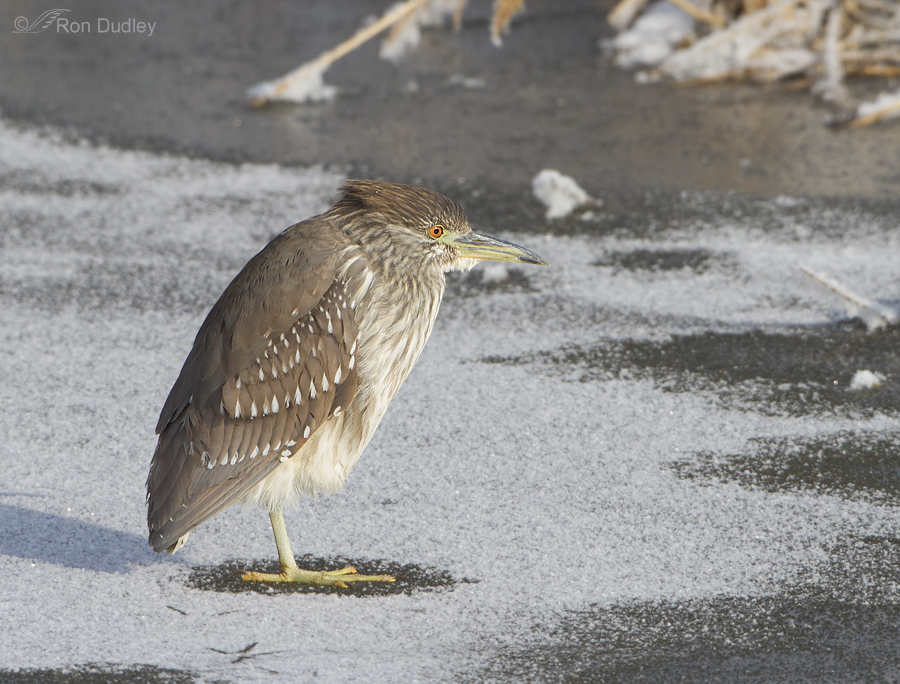
1/1600, f/7.1, ISO 500, 500 f/4, natural light
But after a few minutes that slowly began to change. Thin ice is flexible and the weight of the bird is beginning to bend and crack the ice, allowing water into the resulting depression.
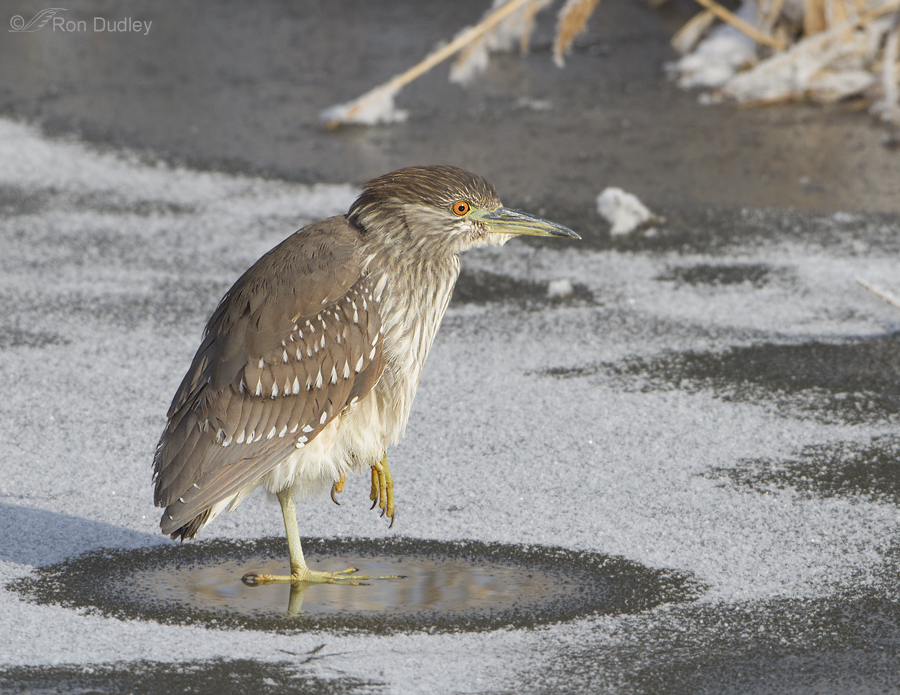
1/1600, f/7.1, ISO 500, 500 f/4, natural light
Here the ice continues to sink and the depression grow. I’m sure the heron is getting “that sinking feeling” and I like the slightly goofy and perplexed expression of the bird as it appears to try to figure out just what’s going on.
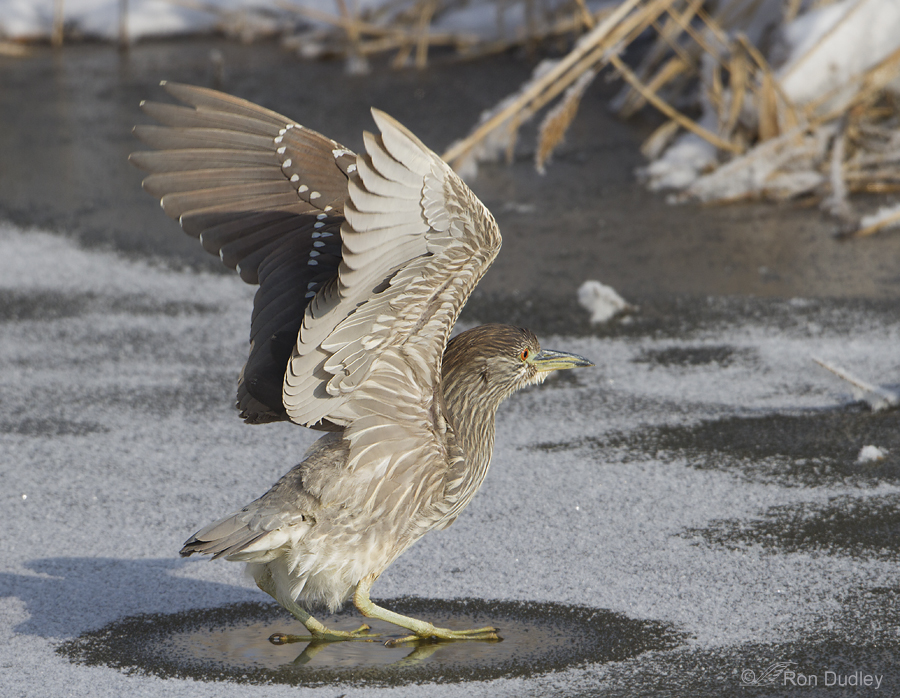
1/1600, f/7.1, ISO 500, 500 f/4, natural light
Finally the bird decides to “abandon ship” and find a more stable hunting platform.
I suspect that seeing this species on ice seems somewhat incongruous to many folks who are used to seeing it in more moderate climates.
Ron


Fantastic! Seeing it on ice is very different, indeed, from what we usually see. Great work!
I love these shots. Thanks for sitting with this bird long enough to watch it slowly sink. I found that amusing. Don’t you love the wonderful things we see when we spend time and patience? I think that is one of the rewards of photographing wildlife (just an idea of a young newbie). The time you put in, coupled with a little luck, can produce the most beautiful rewards.
Ron:
Great shots! and they definitely seem incongruous.
I was surprised by the statement that BCNHs are not found in Australia, because I had a vivid memory of seeing it in my Australia field guide, because it was one of the few that I see in my area. I pulled my field guide off the shelve and found a photo of the bird. The guide says this: Range: breeds mainly in Europe and Asia, south as far as Java, where it nests in colonies with Nankeen; northern populations move south Sept – Apr. Vagrant to Ashmore Reef, so possible in Kimberley and Top End. So, it was in the field guide as a bird that might possibly be spotted, not as a resident or regular visitor to the continent.
I got a number of decent shots of Nankeen Night Heron which we saw regularly.
Dave
Hi Dave, Interesting observation. I got that little factual tidbit from BNA so I went back and looked again at what they said, which was that they “BREED on every contintne except Antarctica and Australie”. So, they may be found there occasionally, just don’t breed there. I’ll go back and correct my text. Thank you.
Incredible detail and a great story! How far do you estimate the bird was from you? Did you shoot from your truck?
Thanks, Chris. I was fairly close to this heron – perhaps 40 feet. And yes, I was shooting from my truck. If I’d been on foot I’m sure the bird would never have let me get that close.
Of course Australia (and wonderful Antarctica) miss out. I loved this series Ron, thank you. Do the adults retain the green on the beak (particularly the lower bill)?
We are still in a heat-wave here so cooling shots of ice were particularly welcome.
I actually thought of you as I was typing that text, Elephants Child – wondering if you have a counterpart to this species down there. The beak of the adult heron is solid black.
Great detail and quality as usual, Ron. Just now I posted about a Least Grebe I think it’s a “vagrant” from the south of Puerto Rico, (I’m from up north). Do you think a “vagrant” Grebe has a chance to reunite with other Grebes, since they are such poor flyers? This Least Grebe might be at least 5,000 miles away from a breeding colony in the south of the island.
Thanks, Maria. Regarding your question, I’m afraid I’d only be guessing since I’m generally unfamiliar with the species. BNA says that the Least Grebe has less wing loading and greater flight ability than any other North American grebe. Seems to me that the bird should have the ability to get back to wherever it came from though…
Thanks for replying Ron. Yes, it’s one of the smaller grebes. I guess my “anthropomorphism” doesn’t leave me alone, and I just feel sorry for it seeing him alone all the time. He feeds himself very well in that pond and seems to be okay.
Thanks for shooting the marvelous pictures that allow me and so many to get a wonderful close up look ath this beautiful juvinile. Your talent and knowledge are truly amazing!
A very nice thing to say, Charlotte. Thank you.
Thanks so much for taking the extra time to share that info, Ron. I really appreciate it.
I only seen Black-Crowned Night-Herons in large groups. In spring and summer there are roosting spots with large populations in areas along the delta that we frequent. I’ve never seen one all alone. Do they disperse in winter and become more solitary or do you think this little on got left behind when the group moved on?
Sharon, I don’t recall ever seeing this species in large groups. Around here they seem to be mostly solitary. Below is what BNA has to say on the subject.
“After a post-breeding dispersal, most (BCN)herons in northern part of range migrate south, although a few winter as far north as Oregon and n. New England”